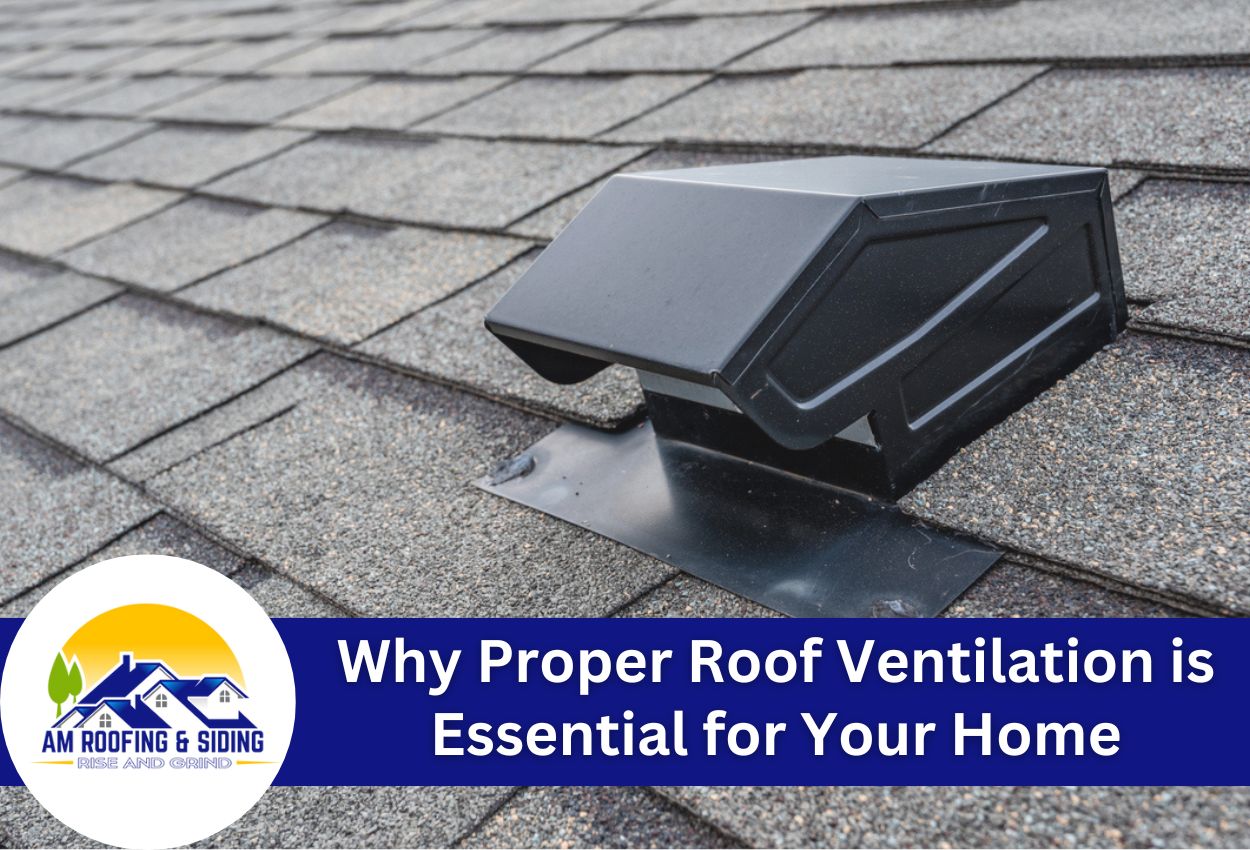Ensuring your home is comfortable and energy-efficient involves many factors, but one of the most crucial yet often overlooked is the importance of roof ventilation. Proper ventilation in your roofing system plays a pivotal role in regulating indoor temperatures and maintaining air quality. It helps prevent the buildup of heat and moisture, which are common culprits behind roofing problems.
Roof ventilation systems work to balance the airflow in your attic, directly influencing your home’s heating and cooling expenses. By enhancing airflow, these vents reduce the burden on your air conditioning units during hot months and minimize heat accumulation under your roof. This not only leads to a more comfortable living environment but also extends the lifespan of your roofing materials.
The benefits of roof vents extend to preventing moisture-related issues such as mold and structural rot. In areas with significant temperature variations, like Central Ohio, effective attic ventilation is a necessity. This article will guide you through the best practices in roof ventilation to ensure your home remains safe, comfortable, and energy-efficient.
The Science Behind Roof Ventilation
Understanding the science of airflow within your roofing system is essential to grasp the importance of roof ventilation. Proper ventilation ensures that air circulates efficiently, entering through intake vents located typically at the roof’s edge or near the soffits and exiting through exhaust vents at or near the roof’s peak. This process helps maintain an optimal temperature and humidity level in the attic, which significantly impacts the overall health and efficacy of your roofing system.
Intake and exhaust ventilation components are crucial in creating a balanced roofing ventilation system. Intake vents allow cool, fresh air to enter the attic, while exhaust vents let hot, moist air escape. This balance between intake and exhaust is vital to prevent the buildup of heat and moisture under the roof, which are common causes of material deterioration and other severe damage.
Improving attic ventilation with the right types of roof ventilation systems has numerous benefits. It not only enhances the energy efficiency of your home by reducing the load on heating and cooling systems but also mitigates potential damages caused by moisture and excessive heat. Adhering to roof ventilation best practices is crucial, especially in regions like Central Ohio, where temperature fluctuations can be significant. Proper roof ventilation ensures that your home remains healthy, structurally sound, and cost-effective in the long run.
Types of Roof Ventilation Systems Explained
Understanding the different types of roof ventilation systems can significantly impact the overall health of your home. Common ventilation options include ridge vents, soffit vents, and turbines, each serving a unique role in enhancing attic ventilation. Ridge vents, positioned along the roof’s peak, allow hot air to escape naturally without the need for moving parts, making them a durable and low-maintenance option.
Soffit vents are installed in the eaves of your roof, allowing fresh air to flow into the attic and balancing the temperature and humidity levels inside. These vents are crucial for maintaining a continuous air flow with ridge vents or other exhaust systems. On the other hand, turbines, also known as whirlybirds, use wind power to actively remove hot air from the attic. While effective, they require sufficient wind to operate optimally.
Each ventilation system has its benefits and limitations. Ridge vents offer excellent ventilation without the need for mechanical parts, making them a popular choice among homeowners. However, they might not be as effective in regions with minimal wind. Soffit vents are essential for proper air intake but must be kept clear of obstructions to function correctly. Turbines provide excellent exhaust capabilities but can be less reliable during calm weather conditions. Choosing the right roof ventilation system involves understanding these dynamics to ensure optimal attic ventilation, which is crucial for protecting your home from the impacts of improperly vented roofs.
How to Recognize Poor Attic Ventilation
Identifying signs of inadequate attic ventilation is crucial for maintaining the health and efficiency of your home. One common indication is the formation of ice dams during the winter months. These occur when heat escapes from a poorly ventilated attic, melting the snow on the roof which then refreezes at the eaves, creating dams that can cause significant water damage. Additionally, unusually high energy bills can be a red flag, as they often suggest that your HVAC system is working harder to compensate for the heat buildup in the attic.
Poor attic ventilation can lead to several serious consequences. Moisture accumulation is a major concern, as it can foster the growth of mold and mildew, which in turn can affect indoor air quality and pose health risks to residents. Furthermore, excessive moisture and heat can accelerate the deterioration of roof materials. Over time, this can weaken the roof structure, potentially leading to costly repairs or even premature roof replacement. Recognizing these signs early can save homeowners in Central Ohio and beyond from facing these severe issues.
Guide to Improving Your Attic Ventilation
Assessing your current attic ventilation is the first step toward ensuring a healthy and efficient roofing system. Start by examining the existing vents to determine if they are sufficient and correctly placed to facilitate effective air circulation.
When choosing enhancements for better air circulation, consider the types of roof ventilation systems that would best suit your home. Adding ridge vents along the peak of your roof can help expel hot air and promote a natural flow of cooler air from soffit vents at the eaves. Alternatively, installing additional intake vents can balance the ventilation system, especially if your current setup does not adequately support the attic’s square footage.
It is crucial to understand the impact of an improperly vented roof, which can range from increased energy costs to severe structural damage over time. Implementing roof ventilation best practices, such as regularly checking for blockages, can significantly enhance the effectiveness of your roofing system. By following these guidelines, homeowners in Central Ohio can improve their home’s energy efficiency and prolong the lifespan of their roofing materials.
Best Practices in Roof Ventilation Installation
Before installing new roof ventilation systems, it’s crucial to consider several key factors to ensure optimal performance. The first consideration is the selection of appropriate vents that match your specific roof type and structure. This involves understanding the types of roof ventilation systems available and determining which one would best suit your needs. Additionally, the layout and size of the roof should guide the placement and number of vents to achieve balanced airflow throughout the attic.
During the installation process, common mistakes can significantly hinder the performance of roof ventilation systems. One such error is improper placement of vents, which can create areas of stagnant air, reducing the overall efficiency of the system. Another frequent oversight is inadequate sealing around the vents, which can lead to leaks and moisture problems. To avoid these pitfalls, it’s essential to follow roof ventilation best practices, which include accurate measuring, careful placement, and thorough sealing and insulation.
Lastly, it’s important to consider improving attic ventilation by integrating additional airflow strategies, like adding soffit vents if not already in place. This enhancement ensures that cool air effectively enters the attic, promoting a more efficient exhaust process through the higher-placed vents. Adhering to these guidelines not only supports the benefits of roof vents but also mitigates the impact of an improperly vented roof, securing the structural integrity and comfort of your home.
Long-Term Benefits of Maintaining Proper Roof Ventilation
One significant advantage of maintaining proper roof ventilation is the extension of your roof’s lifespan. A well-ventilated roof allows for continuous airflow, which helps prevent the accumulation of heat and moisture under the roofing material. This reduction in heat and moisture not only protects the roofing materials from premature deterioration but also prevents issues like mold growth and wood rot.
Additionally, optimized roof ventilation contributes to energy savings and improved air quality within your home. By facilitating a more efficient air exchange, a properly vented roof reduces the workload on your heating and cooling systems, lowering energy consumption and utility costs. This efficient air exchange also improves indoor air quality by minimizing the potential for mold and mildew growth, which are often prevalent in stagnant, moist attic environments.
In regions with dramatic weather changes, such as Central Ohio, maintaining an effective ventilation system is crucial. The benefits of roof vents in such areas are particularly noticeable, as they help stabilize indoor temperatures during extreme weather, contributing to a more comfortable and healthier living environment. Understanding the impact of not having a properly vented roof and implementing roof ventilation best practices can save homeowners from costly repairs and health issues in the long run.
Discover the Long-Term Benefits of Proper Roof Ventilation with AM Roofing & Siding
Don’t let poor roof ventilation compromise your home’s comfort and energy efficiency. Contact AM Roofing & Siding at (740) 974-8268 to ensure your roof’s ventilation system is optimized for maximum benefits. Proper ventilation not only prevents moisture and heat buildup but also extends the lifespan of your roof, saving you money in the long run. Take action now to improve your indoor air quality and maintain a healthy, durable roof. Reach out to AM Roofing & Siding today for expert advice and installation of the best ventilation systems tailored to your home’s needs.

